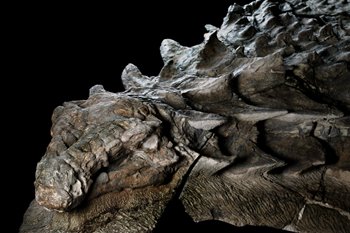The Dinosaur Fossil from Cretaceous Canada
May 17, 2017
 Last week, Canada’s Royal Tyrrell Museum of Paleontology unveiled a dinosaur fossil like no other. What makes this fossilized nodosaur so unique is how well preserved this specimen is. Weighing in at a slim 2,500lbs, the fossil is so well preserved that you can make out the details in its face and scales. No other specimen has been found with such a level of preservation, and seeing it is more like looking at a sculpture of a dinosaur than a skeleton. What’s especially fascinating about a find like this are the various intersections of science that led to this colossal discovery.
Last week, Canada’s Royal Tyrrell Museum of Paleontology unveiled a dinosaur fossil like no other. What makes this fossilized nodosaur so unique is how well preserved this specimen is. Weighing in at a slim 2,500lbs, the fossil is so well preserved that you can make out the details in its face and scales. No other specimen has been found with such a level of preservation, and seeing it is more like looking at a sculpture of a dinosaur than a skeleton. What’s especially fascinating about a find like this are the various intersections of science that led to this colossal discovery.
Physics: The current hypothesis on why the nodosaur is so well preserved hinges on a series of fortunate events after the creature’s demise. The nodosaur either drowned in a river or fell into it after dying in some other way. Prevailing winds and/or currents caused it to float out to sea, buoyed by the gasses of its decomposing interior. Eventually, the gases popped and the remains sank into the sea. Since the nodosaur’s armor-plated back is heavier, it sank back-first and landed in a section of seafloor composed of soupy mud, essentially pressing its shape into the seafloor to form a protective mold of itself. Eons worth of rocks piled on it, further protecting it from the elements and allowing the remains to safely petrify.
Geophysics: Of course, this discovery wouldn’t be possible without the many changes that occurred to the land and sea around the final resting place of the nodosaur. The area where the nodosaur was found was once a body of water known as the Western Interior Seaway. Plate tectonics eventually closed off this interior sea and as the land changed and ice ages came and went, not only did the waters recede, but the physical composition of the area also changed. The oil sands region where the nodosaur was found is specifically mined because ancient glacial activity scraped part of the surface of the land away, allowing easier access to the natural resources below.
Mechanical Engineering: Ultimately, the only reason that this spectacular specimen was found was due to the fact that the Suncor Millennium mine is an active industrial site with heavy machinery moving tons of earth every day. As Donald Henderson, the paleontologist who was first called to evaluate the find, puts it, “We would never see this stuff if it weren’t for the industrial activity.” The machinery used at the mine is the culmination of decades of engineering and is so advanced that, although capable of handling a 100-ton capacity, the backhoe that found the nodosaur was sensitive enough to not damage it. The machines from the mine were also critical in extracting the nodosaur and likely saved hundreds of man hours of manual excavation.
After six years of cleaning and preparation, the nodosaur is finally on display for the world to see. Its journey from the banks of a prehistoric sea to its final resting place inside a glass case in a museum has been a long and harrowing one, but now it can inspire future generations of scientists as they come to visit it and ponder the many scientific feats that allowed for it to re-join us on the surface.